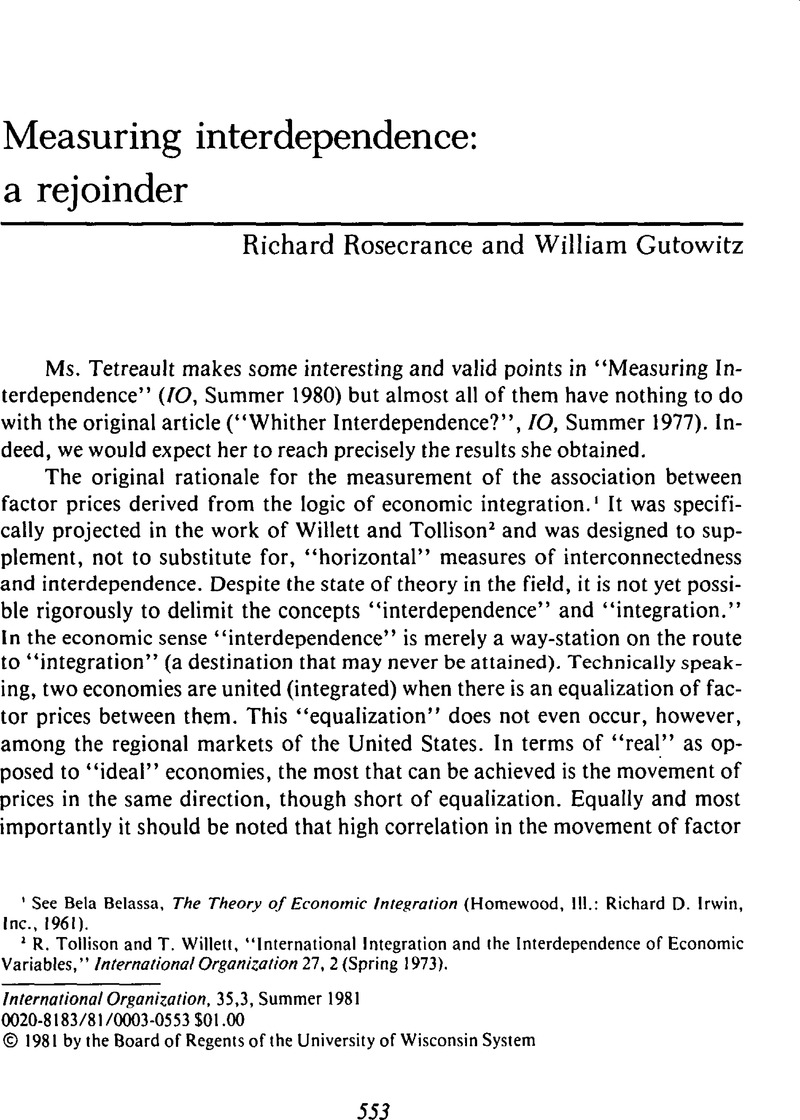No CrossRef data available.
Article contents
Measuring interdependence: a rejoinder
Published online by Cambridge University Press: 22 May 2009
Abstract

- Type
- Comments
- Information
- Copyright
- Copyright © The IO Foundation 1981
References
1 See Belassa, Bela, The Theory of Economic Integration (Homewood, III.: Richard D. Irwin, Inc., 1961)Google Scholar.
2 Tollison, R. and Willett, T., “International Integration and the Interdependence of Economic Variables,” International Organization 27, 2 (Spring 1973)CrossRefGoogle Scholar.
3 Rosecrance, J R. et al. , “Whither Interdependence?” International Organization 31, 3 (Summer 1977), p. 429CrossRefGoogle Scholar.
4 Ibid.
5 Her dismissal of this point is ill-advised: “Because all of the data were indexed to begin with, and because the correlation procedure detects relative movements by itself, 1 felt that these ‘delta’ correlations were unnecessary” (“Measuring Interdependence,” p. 434). Actually, absolute cor-relation measures cannot correct for uniform increases in the data, as she recognizes elsewhere (p. 432).
6 Our original article went to great lengths to challenge this point: “But as we have seen above, a greater ‘connectedness’ in international politics does not necessarily mean higher interdependence. Whether it does or not depends upon how nations react to the increasing international sector. Some states may develop common policies while others fashion opposed policies. Some nations may try to reduce the domestic impact of international economic forces; others may shape policies to conform with their impact” (Rosecrance, et al. , “Whither Interdependence?”, p. 427)Google Scholar.
7 Yet it is not clear whether she regards the MSI as a measure of “interdependence” or a measure of “inflation.” If the latter (see pp. 434, 439), one wonders why she thinks it would be at all useful in charting dyadic relationships.
8 Rosecrance, et al. , “Whither Interdependence?”, p. 442Google Scholar, emphasis added.
9 Thus high and uniform inflation in a series of countries probably does indicate the common operation of an “international sector” upon national economies. The world, or even individual national economies, were not always so closely linked. See Pintner, Walter, “Inflation in Russia during the Crimean War Period,” American Slavic and East European Review, 02 1959Google Scholar, for an analysis showing that the economic effects on Russia of the Crimean War were largely con-fined to the Crimea.




